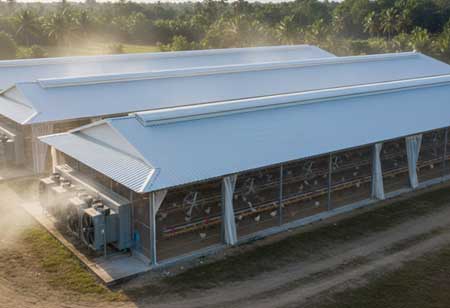Thank you for Subscribing to Agri Business Review Weekly Brief
Optimizing Poultry Health and Profitability Through Environmental Control Strategies
Poultry production in tropical regions faces major challenges due to high temperatures and humidity. Effective management strategies—encompassing housing design, ventilation, cooling systems, and tailored nutrition—are essential to reduce heat stress and maintain optimal productivity.

By
Agri Business Review | Tuesday, November 04, 2025
Stay ahead of the industry with exclusive feature stories on the top companies, expert insights and the latest news delivered straight to your inbox. Subscribe today.
Fremont, CA: The persistent combination of high heat and humidity in tropical regions poses a major challenge to sustainable and profitable poultry production. Chickens, which cannot sweat, rely on panting to release excess heat, but elevated humidity greatly reduces the efficiency of this natural cooling mechanism. The result is heat stress, which can severely affect bird welfare, feed intake, growth, egg production, and survival. Addressing this challenge demands a comprehensive and strategic approach, integrating effective cooling, ventilation, and optimized husbandry practices.
Architectural and Structural Solutions
The design of the poultry house serves as the first line of defense against the challenges of the tropical climate, making housing orientation, structural features, and climate control systems critical to maintaining bird health and productivity. Proper orientation is essential, with houses ideally aligned along an east–west axis to minimize direct solar exposure on the longer sides during peak sunlight hours. Insulated roofs and walls further reduce heat transfer, with the roof being the most critical surface, as it accounts for nearly 60 percent of heat gain. Therefore, the use of high-quality insulation materials or reflective coatings is indispensable. Incorporating high ceilings allows greater air volume, enabling warmer air to rise and delaying internal heat buildup. Ventilation plays an equally important role by removing excess heat and moisture generated by birds and litter. Natural ventilation can be optimized in open-sided houses through wider eaves, adjustable curtains, and steeper roof pitches.
In contrast, tunnel ventilation in closed or semi-closed systems offers superior climate control. By creating negative pressure with high-capacity fans, tunnel systems ensure uniform airflow at high velocity, generating a wind-chill effect that lowers the effective temperature experienced by the birds. Supplemental circulation fans at bird level remain vital even in naturally ventilated houses to prevent stagnant air pockets. Evaporative cooling methods may also be employed, though with caution, as they simultaneously increase humidity. Cooling pads, commonly used in conjunction with tunnel ventilation, effectively cool incoming air when outdoor humidity is not excessive. Foggers and misting systems can also provide relief but require careful monitoring and intermittent use to avoid creating overly humid conditions that could exacerbate heat stress rather than alleviate it.
Nutritional and Management Adjustments
Technology alone cannot safeguard poultry from the challenges of rising temperatures; effective adaptation requires daily farm management practices tailored to climatic realities. Water management is critical, as birds under heat stress may increase water consumption two- to fourfold. Ensuring constant access to cool, clean water—ideally at a temperature below 25 °C—is essential, with routine flushing of water lines to prevent biofilm buildup and maintain freshness. Supplementation with electrolytes such as sodium and potassium, along with vitamins, particularly Vitamin C, can further support birds by restoring acid-base balance and reducing physiological stress caused by panting. Feeding strategies must also be adjusted to minimize heat load, since digestion itself generates metabolic heat. Shifting major feeding times to cooler periods, such as early morning, late evening, or even midnight with lighting support, helps avoid peak temperature stress. Nutritional adjustments, including reducing dietary protein while balancing amino acid requirements through synthetic sources and incorporating energy-dense, low-heat increment ingredients like fats, further mitigate heat stress. Stocking density and litter management are equally important. Lowering bird density during hot periods improves air circulation and reduces cumulative heat. Maintaining dry litter through proper ventilation, regular de-caking, and turning prevents excess humidity that impairs evaporative cooling.
Balancing the demands of heat and humidity in tropical poultry farming is a fine art that requires science-backed strategies. The most successful operations rely not on a single remedy, but on an integrated environmental control program. This includes investment in climate-resilient housing design, sophisticated ventilation and cooling systems tailored to local humidity levels, as well as nutritional and water management. By diligently implementing these strategies, farmers can successfully mitigate the effects of heat stress, ensuring better animal welfare, sustained productivity, and long-term economic viability in challenging tropical environments.





